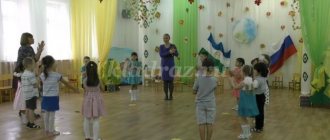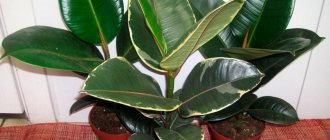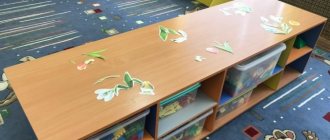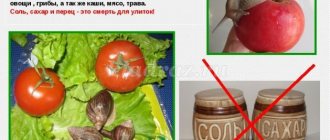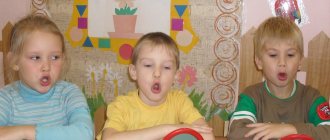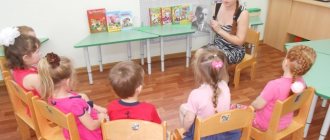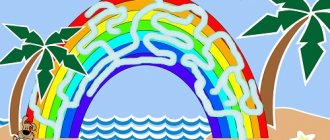Summary of GCD in the senior group “Modes of Transport”
Summary of GCD in the senior group.
Topic: “Types of transport. Professions of people working in transport."
Program content
: - expand children’s understanding of the classification of modes of transport depending on the environment of movement and destination;
-continue to formulate concepts: ground, air, water; cargo, passenger, special;
- consolidate knowledge about the professions of people driving vehicles; -develop the mental and speech activity of children using visual modeling technology.
Activating the dictionary:
Conscientious, hardworking, diligent, polite, responsible, courageous, skillful, vigilant, disciplined; water, air, land, underground, passenger, cargo, special, names of transport professions.
Equipment:
— Handout subject pictures depicting a variety of vehicles. -Canvas “Sky – earth – water”. -For modeling: circles symbolizing modes of transport (blue – air; black – ground, underground; blue – water) – with a diameter of 15-17 cm; circles - symbols of modes of transport depending on the purpose (yellow - passenger, brown - cargo, red - special, rescue) - with a diameter of 5-6 cm.
Preliminary work:
-Examination of subject and plot pictures on the topic “Transport”, conversations on them. -Observing transport while walking. — Excursions “Journey to the land of road signs”, “Cars on the streets of our city”. -NOD “Road rules are reliable rules.” — Selection of a library and creation of a card index of poems and riddles about transport. — Creation of a corner of educational games on the theme “Transport”: puzzles, board games (“Assemble a car or plane,” “Fix the equipment,” “What’s extra,” cut-out pictures “Transport”) — Director’s game “Dispatcher” using sets of different pictures types of transport. — Coloring pictures with pictures of vehicles. — Exhibition of children’s crafts made from natural and waste materials together with parents on the theme “Transport.”
GCD move:
Educator
reads a poem: “The train is moving, the train is rushing, its wheels are knocking.” A river flows under the mountain, and there is a steamboat on the river. A car is driving along the highway; it has large tires. A plane rushes into the sky, inviting all its friends to fly. He carries cargo and people, what is this - tell me quickly?
-What do you think we will talk about in class today? Yes, that's right, about transport. What is transport? (This is something you can use to move around and transport cargo). Game
"Flies, swims, rides." (
Game task: to consolidate in the minds of children the idea of types of transport according to the environment of movement.)
- Listen to the rules of the game. I will ask riddles about transport, and you must think and guess them correctly. Riddles-pictures are on your tables, the answer must be attached to the canvas “Sky, earth, water” ( Riddles about
a bus, train, truck, subway, plane, helicopter, rocket, boat, motor ship, submarine
) - There are different types of transport: -What's floating?
Boat, cutter, yacht, sailboat, ship. - What's going on? Bus, bicycle, car, truck, train, motorcycle. - What flies? Rocket, airplane, helicopter, airplane, airship. Educator:
- What is the name of a vehicle that moves on water? (Water transport). What is the name of a vehicle that moves through the air? (Air transport) - What is the name of transport that moves on the ground? (Ground transport), underground? (underground)
Each type of transport will be designated by different colors (the teacher attaches large circles to the board): blue - air, black - ground, underground, blue - water.
Didactic game
“Confusion”
1) We fell in love with air transport, 2) Cars fly faster than all birds. 3) Doctors take us all to work in the morning. 4) We flew to the Black Sea in May by tram. 5) Today we were brought to kindergarten in a car - just great! (Children point with their hands and answer in unison: yes, yes...... no, no)
Educator:
— Think carefully and answer, why do people need transport?
(Children's answers). — Cars were invented and made by people to make their work easier, to move long distances themselves and to transport heavy loads. To operate a machine, you need to know a lot. — What do you think is how machines can work and move? (Children remember details of an airplane, car, helicopter, train). ( exhibited: airplane, helicopter, truck, train, trolleybus, motor ship)
Didactic game
“What would have happened?”
What would happen if...the car's doors disappeared (the car is rushing at high speed). ...gas tank gone? ...the headlights are missing? (at night, in the fog.) ... would the bicycle lose its pedals? ... the plane's wings disappeared ... the seats in the cabin disappeared? ... the excavator has lost its bucket? ... the truck body is missing? ... the boat's oars are missing, and the boat is in the middle of the lake?
Educator: -
We found out: in order for a car to move, it needs a motor, gasoline... and what else? After all, she won’t go on her own! (Children's answers....) - Of course, we need a person to drive the car, but what is this person called?... Driver. Let's remember the professions that are related to the management of vehicles?
(Children's expected answers: Driver - drives a car, conductor - distributes tickets for travel, auto mechanic - repairs cars, taxi driver drives a taxi, tractor driver works on a tractor, crane operator on a crane, etc.). -What should these people be like? ( attentive, brave, etc.)
All the roads are familiar to me, I feel like I’m at home in the cabin. The traffic light is flashing for me, He knows that I am... (Children's answers).
-Yes, this is the driver. The driver or, as he is also called, the driver. What qualities do you think a good chauffeur or driver should have? What should he know and be able to do? (Children's answers) But the most important thing is that the driver must know the traffic rules very well, because the safety of both passengers and pedestrians on the roads depends on this. It is very important!
-What is the name of the person who flies the plane?: The man who flies the plane is called a pilot. -Pilot, or pilot. What is a pilot flying a plane like? He must be brave, courageous, skillful. By analogy, we find out who controls different types of transport: train, ship, rocket, bicycle.
Game
“Name the profession”
Who drives a bus or a car? (attentive driver) Who flies on an airplane? (brave pilot) Who controls the train? (sharp-eyed driver) Who flies the rocket? (skilled astronaut) Who controls the ship? (conscientious captain) Who rides a motorcycle or bicycle? (brave motorcyclist, disciplined cyclist) Who flies a helicopter? (responsible pilot).
Physical education lesson:
-
Imagine, guys, that we are traveling on various types of transport, now we will depict it.
The pilot and I will fly. Hands to the sides, we send the plane into flight. Left wing forward, right wing forward, One, two, three, four - our plane flew. By car we drive fast, fast, (hands hold the steering wheel, turn the steering wheel) The train rushes at full speed (arms bent at the elbow, train movement) Chuh-chuh-chuh-chuh! We take the oars in our hands and quickly row towards the shore. A boat has landed on the shore. We will jump onto the shore deftly. And let's jump across the lawn Like bunnies, like bunnies.
Educator
: — Transport is used for movement on land, water, air, for the transport of passengers and cargo.
Can we divide ground transport into groups depending on its purpose? (Children's answers...) Teacher
(sums up the children's answers): - Yes! Transport can be: passenger, cargo, special. Children, at the teacher’s suggestion, independently reveal the purpose of each of these types of transport and name the vehicles (at the same time, the children’s answers are translated into a diagram by the teacher):
-Passenger transport is busy transporting passengers, i.e. people: buses, trams, trolleybuses, taxis, trains, planes, sea liners, etc. -Cargo – transports cargo: trucks, freight trains, airplanes, ships, etc. (the explanation is accompanied by showing illustrations and photographs of transport). — Special transport is needed for very important work. They are called by telephone if urgent assistance is required: a fire truck, an ambulance, a police car. What phone numbers are dialed in case of a fire? Sick? What if something happened?
Air and water transport are also divided into types according to purpose. The diagram is drawn up as follows: for each large circle, indicating the type of transport depending on the medium of movement (black - ground, underground; blue - air; blue - water), smaller circles are attached (yellow - passenger, brown - cargo, red - special, rescue )
Didactic game
“4th extra”
(Working on cards - mutual testing in pairs): consolidating and testing children’s knowledge on the topic).
Summing up the lesson using the diagram.
Summary of GCD for FCCM in the senior group “Wind”
Ilvira Bikbulatova
Summary of GCD for FCCM in the senior group “Wind”
Summary of GCD for formation
a holistic picture of the world
in the senior group
«Wind»
Cognition - to form children’s knowledge about such a natural phenomenon as wind , the reasons for its occurrence, the role in the life of living organisms, including humans, the ability to find the causes and consequences of events, maintain and develop interest in nature and its phenomena, the relationship between man and nature, develop ecological thinking in the process of conducting elementary experiments;
Speech - develop the ability to correctly construct sentences, using linguistic means to connect their parts, develop the ability to name antonym words;
S/K. — consolidate knowledge on the topic through the d/game “Say the other way around”
;
F. - intensify physical activity.
Material: Illustrations of animals and insects, boats, sailboats, plant seeds, plates with cotton wool on children’s tables, a boat with a sail.
Progress of the lesson: Today we will talk to you about one natural phenomenon. Which one, guess for yourself.
I'll shake the birch tree
I'll push you
I'll even steal my hat.
But I can't be seen.
Who am I? Can you guess? ( wind )
.
-Do you know what wind ?
— Wind is the movement of air.
-Wave your hand near your face, blow on your hand, what do you feel? ( breeze ,
When we wave our hand or blow on our hand, we are moving air.
-Why do they say about him that he is powerful? What can he do? (make noise, hum, shake trees, rustle leaves, howl, wave flags, whistle, raise dust, tear off leaves, collect snow in snowdrifts, etc.)
-Do you think we need wind ? (needed)
.
-Of course it is necessary, if there was no wind, then all the clouds would gather in one place, and it would rain only in one place. And here on earth it wouldn’t be so beautiful.
— The wind blows the clouds in all directions and it rains everywhere.
the wind for ? (to clear the clouds, if they don’t answer, a leading question:
-What does the wind do in the sky ?
-And in hot weather we need wind , otherwise we would be very hot and stuffy.
-In what weather do we need wind ? (children's answers)
-The wind helps spread plant seeds and disperse trees to new places.
-How do you think he does it? (demonstration: take flower and birch seeds in your palm and blow on them)
.
-That's why flowers, grass, trees grow everywhere.
-So, how are plant seeds dispersed? ( the wind blows and carries them away )
.
— The wind also helps animals , for example: wolves, they determine where the prey is located in the direction of the wind. (picture of a wolf, fox and other animals)
.
-How does the wind help animals ?
helps insects , for example, newly born spiders, find new housing. Spiders weave parachutes from their webs. The wind inflates these parachutes and blows them in different directions. (picture of a spider)
.
-The wind also helps a person when he turns the mills. (showing a picture)
.
-The mill grinds grains into flour.
-In the old days , ships sailed across the seas and oceans with the help of sails, because there were no engines or gasoline before. The wind inflated the sails , and so the ships sailed on the waves. (experiment with a boat in a basin of water)
.
-I am the Wind , I blow on the sail of a boat.
-What's going on with the boat? (he is swimming)
.
- I’ll blow even harder, he’ll swim faster. Likewise, large ships move thanks to the wind.
-What happens to the ship if there is no wind? (the ship is standing still)
.
-What if the wind is very strong ? What will happen to the ship? (the ship can capsize and become shipwrecked)
.
blows in our faces
The wind is quieter , quieter, quieter
The tree is getting higher and higher. (movements in accordance with the text)
-But the wind can also harm a person. Sometimes he destroys houses, breaks trees in the garden, overturns cars, and rips off hats.
-What is a hurricane, tornado, storm? (it's a strong wind )
.
- Guys, do you want to be the wind? (experiment with cotton wool, children blowing on cotton wool)
.
-You are the wind ! You blow on cotton wool, what happens? (the cotton wool moves across the table)
. The harder you blow, the faster the fleece moves.
-What kind of wind ?
-In warm weather - warm
Summary of the lesson on FCCM in the senior group on the topic “Transport”
Galia Ismagilova
Summary of the lesson on FCCM in the senior group on the topic “Transport”
Municipal Autonomous Educational Institution
Combined kindergarten "Rodnichok"
Municipal district. Chishminsky district
FCCM lesson
Topic: " Transport "
Educational area: cognitive development.
Goal: to develop children’s knowledge on the topic “ Transport ”
:
(air, land, water, special vehicles)
Educational objectives: continue to consolidate children’s knowledge about various types of transport (land, water, air, special)
;
reveal the importance of transport in people's lives .
– developmental tasks: develop children’s speech, teach them to answer the teacher’s questions in complete sentences; develop attention, memory, thinking; the ability to classify transport by type , develop gross and fine motor skills; maintain optimal physical activity of children in order to prevent fatigue and ensure a change in activities.
— Strengthen children’s knowledge of traffic rules
Educational objectives: to develop the ability to coordinate one’s actions with the actions of others, to listen carefully to a friend’s answer; cultivate perseverance; interest in unconventional technology
Types of children's activities: cognitive, communicative, playful, motor.
Equipment: Toys: helicopter, bus, truck, tractor, police car, ambulance, passenger car, airplane, boat, speedboat, watercolor paints, sponge, napkins, album sheet.
Individual work: providing individual assistance to children as needed (showing, explaining, clarifying)
.
Abstract of GCD on FCCM for children of the senior group on the topic: Types of transport
Abstract of the GCD for children of the senior group, developed in the technology of the activity method “Situation” according to the Federal Center for Competitive
Education Educational area : “Cognitive development” Educator: Stolyarova Natalya Aleksandrovna. Topic : Types of transport. Goal: Formation of children's ideas about types of transport: air, land, water. Objectives: 1. Reveal the importance of transport for people. 2. Summarize and systematize children’s ideas about human movement. 3. Establish rules of conduct in public transport and at bus stops. 4. Train mental operations: analysis, comparison, generalization and analogy. 5. Develop students’ logical thinking, attention, and memory. Materials: cards with images of transport, map, green, red and yellow flags. Progress of the educational situation. 1. Introduction to the situation.
Didactic tasks: motivate children to engage in gaming activities.
The teacher gathers the children around him. — Do you like to travel? — Which of you vacationed this summer and where? - How did you get there? On what? The teacher says that Dunno also wanted to go on a trip to the moon. But he doesn’t know how to get there from his flower city. - Do you want to help him? - Can you do this? “Then let’s go to Dunno in his Flower City.” 2. Updating knowledge.
Didactic tasks: to update children’s knowledge of the names of transport, why it is needed, how to use it, the components of transport.
Children approach the table on which there are cards with pictures of transport. — Cards with images of transport are laid out on the table. -What lies in front of you? (children list the names of transport: car, train, plane, bicycle, boat, balloon, etc.) - How can you call it in one word? (transport) The teacher praises the children and creates a situation of success. 3. Difficulty in a game situation. Didactic objectives: 1. Create a motivational situation for the formation of children’s ideas about types of transport; 2. To form experience, under the guidance of a teacher, of fixing the difficulty and understanding its cause. The teacher offers to choose the transport that Dunno will need for the trip. And he clarifies that you need to choose three types of transport. As a rule, children are lost and do not know what to choose. — Were you able to choose? - No - Why couldn’t they? — We don’t know the types of transport. - So what do we need to know? - Types of transport. 4. Discovery of new knowledge. Didactic objectives: 1. To form in children an idea of types of transport; 2. To form the experience of independent discovery and emotional experience of the joy of discovery. Children approach the table on which there is a map. The map shows: a flower city, land, sea, and destination - the moon. — How can Dunno get to the moon? - How will he travel from the flower city to the sea? (by car, by train, by bicycle) - What will it sail across the sea? (on a ship, boat, steamer) - How will he get to the moon? (on a rocket, on a plane, on a helicopter) The teacher praises the children. - But we only need to choose three types of transport, and to find out we need to solve riddles. - Can you? The teacher sits the children on the carpet and turns on a presentation about types of transport. 1 slide. Doesn't fly, doesn't buzz, the beetle runs down the street. And two brilliant lights burn in the beetle’s eyes. Car - So, what will Dunno drive first? (by car) - On what surface does the car move? (on the ground) - So what type of transport is this? (ground) - What is a ground mode of transport? (these are cars that transport people and goods on land) - What else applies to ground transport? (bus, bicycle, taxi, truck, etc.) 2 slide. It swims bravely through the waves, without slowing down, only the car’s hum is important. What's happened? Steamboat - What will it go on next? (on a steamboat) - On what surface does the steamboat move? (by water) - What type of transport is a steamship? (to water transport) - What else applies to water transport? (ship, boat, motor ship, yacht, etc.) 3 slide. She always flies between the stars, She doesn’t need warmth and light. The answer to the riddle is very simple: After all, this is a fast... ( rocket ) - How will it get to the moon? (on a rocket) - What does the rocket move on? (by air) - What type of transport is the rocket? (to air) - What else applies to air transport? (plane, helicopter, etc.) - Well done! - So what types of transport can Dunno use to get to the moon? (by car, steamship and rocket) - What types of transport did you become familiar with? (land, water and air). The teacher says that Dunno thanks them for their help and goes to the moon. — You were able to send Dunno to the moon because you know what types of transport transport is divided into. 5. Incorporation of new knowledge into the knowledge system. Didactic objectives: 1. To consolidate the idea of types of transport; 2. Organize active recreation for children. Outdoor game “Traffic Light” Children become a chain one after another. At the teacher’s signal (“Start the engines! R-rr-r-r-r”), the children begin to move, and the teacher controls the movement by raising a flag of the appropriate color - red - stop, yellow - moving in place, or green - moving. Game “Sort out transport by type” Cards are laid out on the table, the teacher divides the children into three subgroups: the first subgroup collects land transport, the second – water transport, the third – air transport. 6. Summary of the lesson. Didactic tasks : to restore in the children’s memory what they did and create a situation of success. Children gather around the teacher. - Who did you help today? - How did you help? — What knowledge helped us send Dunno to the Moon?
We recommend watching:
Summary of GCD for introducing older preschoolers to the work of the poet Fet Summary of plot-based GCD in physical education for children of the senior group Summary of GCD in the senior group of compensatory orientation GCD in kindergarten for older preschoolers
Similar articles:
Summary of GCD in the senior group on the topic “Communication”
Summary of GCD in the senior group of kindergarten on the topic “Relaxation”
Summary of a lesson on cognition in the senior group on the topic “Dairy products”
Summary of a lesson on cognition in the senior group on the topic “Construction professions”
Abstract of educational activities for cognition in the senior group of kindergarten on the topic “Russian folk crafts”
Notes on speech development in the senior group on the topic: "Transport"
Summary of educational activities for speech development in the senior group on the topic:
“Transport”
Educator: Putimtseva G.A.
Program tasks:
image.:
formation of ideas about transport and its purpose;
clarification and expansion of vocabulary on the topic;
development
: development of dialogical speech, speech hearing, visual perception and attention, curiosity, thinking, fantasy and imagination;
will educate
.: to cultivate respect for the driver’s profession, cooperation skills in the game and in class.
Vocabulary work:
transport, air, water, land, driver, pilot, passenger.
Equipment:
pictures of all types of transport; pictures depicting transport, in which a number of errors were made.
Progress of the lesson
I. Org. Moment.
V.: Children, I am very glad to see you all today.
Let's stand in a circle, hold hands and greet each other with a smile. It’s wonderful, your smiles immediately made me feel brighter and warmer.
Introductory conversation.
Q: Guys, do you like to travel? (children’s answers)
V.: great!
Then today I invite you to go on a journey, and on what, you will find out if you solve my riddle.
Behind the smoke, behind the whistle,
Brothers running on foot
Did you guess? (children's answers)
V.: That’s right, so what will we use on our journey? (children’s answers)
V.: Great, you guessed how great you are!
V.: Well, now we can go on a journey, let's remember the rules of staying on the train:
“Listen carefully, don’t disturb others,
When they ask you, then answer.”
Well done, take your seats (children sit on chairs)
I I. _ Main part.
V.: On the ground, in the air and in the water, transport serves one important purpose - transporting people and cargo. Cars carry food, toys, medicine, everything that is needed in different parts of our planet. Tourists and lovers of long journeys are sailing on ships. And if people and cargo need to be delivered faster, then airplanes help with this: passenger and cargo. One plane can accommodate more than five buses.
Q: The train is ready to depart, are you ready? (children’s answers)
V.: great! Then our train sets off!
V.: attention! The train arrives at the first station "Guessing Game"
V.: Look at the pictures and guess what kind of transport I’m talking about:
-this machine helps people put out fires. (children’s answers)
-Which machine helps the doctor. (children’s answers)
-This car helps the police. (children's answers)
V.: Well done guys, you completed this task.
V.: attention, our train continues its journey, we are moving on.
Q: we arrive at the second station, it is called “Riddle”
, here we will solve riddles
Four wheels, rubber tires,
Motor and brakes...What is it called? (Car)
Here is a steel bird, aiming for the sky,
And it is driven by a pilot. What kind of bird? (Airplane)
Accurately, on time and deftly, I pull up to the stop.
Everyone entered, the door closed, “You are passengers now.” (Bus)
A white goose is swimming - its belly is wooden,
The wing is linen. (Yacht)
V.: Well done! We completed the tasks at this station.
V.: Attention! Our train is moving on, we are arriving at the third station “Name it”
V.: Look carefully at the screen and tell me the name of the transport on which:
- fly through the air? (children's answers)
Q: What is the name of the transport on which:
- float on water? (children's answers)
Q: What is the name of the transport on which:
— do they travel on the ground? (children's answers)
V.: Great, you make me very happy with your correct answers.
IN.:
Well, our train departs further and we arrive at the fourth station
“Upravlyayka”
“Who controls what”
V.: I will show cards and ask the question “who controls this or that equipment?” and you answer me.
Q: Who flies the plane? (children's answers)
Q: Who drives the car? (children's answers)
Q: Who controls the rocket? (children's answers)
Q: Who controls the ship? (children's answers)
Q: Who drives the bus? (children's answers)
Q: Who controls the train? (children's answers)
Q: How can you call what you called in one word? (children's answers)
IN.:
Our journey continues, and we arrive at the fifth station
“Otdyhaika”
Fizminutka in the form of a game “Flies - does not fly”
.
V.: I call transport, if it is airborne you show “wings”
, and if not, stomp your feet
-helicopter, metro, airplane, rocket, tram, bus, trolleybus, satellite, parachute, boat.
V.: Well done! Then we get into the trailers and move on.
V.: Take a seat at the tables.
V.: Children, we have arrived at the sixth station “Sobirayka”
A game «
What's extra
?
with cards
V.: Move the leaves towards you, take a pencil. You need to find an extra item in each line and circle it. You will complete the task yourself. Let's check. Say what you circled and explain your choice. If anyone has any errors, please correct them. -ship, yacht, boat, raft
-helicopter, hot air balloon, bird, plane
-tractor, bicycle, car, trolley
-train, baby stroller, truck, motorcycle
V.: Well done children, we need to hurry, they are already waiting for us at another station.
Attention! Attention! Please look ahead, the train is arriving at the Shutilka
Q: Guys, there lives a wonderful artist at this station who paints unusual paintings, and do you want to look at them?
V.: then let's look at them, think and determine what is unusual in these paintings. Let's find the artist's mistakes.
(in this picture the plane has wings like a bird).
V.: great.
(in this picture the bicycle wheels are square, not round).
V.: wonderful.
Did you like the artist’s unusual paintings? (children's answers)
V.: Guys, the time of our journey is coming to an end, they are probably already completely tired of waiting for us in kindergarten.
Attention! Our magic train arrives at the terminal station “Kindergarten”
Get off the train, let's say goodbye to him
V.: wave goodbye to the train
III. Summary of the lesson.
Q: Did you enjoy our trip? (children's answers)
V.: Please come to me.
Let's remember all the stations we visited today.
And please tell me which station you liked best (children's answers)
V.: wonderful! Children, you are so good! We completed a lot of tasks correctly today! I'm very glad for you.
